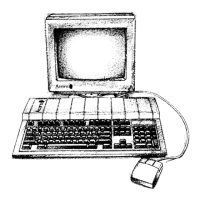screen mode — Governs the physical appearance of the
desktop
on your monitor.
scroll arrows — Arrows at either end of the
scroll bars
on
windows
that are not large enough to
show all of a
file.
scroll bars — Shaded bars along the righthand (and sometimes lower) edge of a
window.
scrolling — Moving around a large
file
using the
scroll
bars and
scroll arrows.
Select button — Lefthand
mouse
button. Use this to select items, choose
menu
options, drag
icons etc.
self-tests — A series of tests performed by the computer when you switch on.
Shutdown — Menu option on the
task manager icon bar menu.
Choose this before you switch
off the computer – it ensures that the computer shuts down 'gracefully'.
slider — Box within
scroll bar. Drag
it to move around a
file.
source disc — See
destination disc.
spindown delay — An option in the Hard disc drives window of !Configure. storage devices
— See
devices.
subdirectory — Directory in a
parent
directory.
submenu —
Menu
accessed by moving the
pointer
over an arrow on a main menu. system
application — Contains some of the
resources
that are common to all
applications.
Task manager — Icon on righthand side of
icon bar.
Use it to control how the computer uses
its memory.
title bar — Along the top of a
window
in which the name of the
file, application
or directory
appears.
toggle size icon — Icon in the top righthand corner of a
window. Clicking
on this toggles
between full size and the last size at which a window was displayed.
toggling — Switching something between two states, usually by clicking Select.
tracks — Areas defined on a disc when you format it, on which the computer stores information.
typewriter keys — Block of keys on the keyboard which resemble those on a typewriter.
window — Area of the screen designated for a particular activity or display – e.g. an Edit
window (used to create a text file) or a
directory display
(used to display the contents of a
disc).
writable menu box — A submenu option or part of a larger menu box. Either it already has a
caret
in it, or the
pointer
changes to a caret when it is over the box, indicating that you
need to type in something (e.g. a file name).
write-protect — To lock a
floppy disc
so that the information on it cannot be changed in any
way.
96

